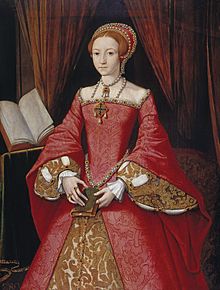Thomas Parry was Lady Elizabeth’s Cofferer and was one of the servants close to Elizabeth who was interrogated during the downfall of Sir Thomas Seymour, Baron Seymour of Sudeley and Lord High Admiral.

As the Cofferer, Parry would have been responsible for in the incoming and outgoing money that belonged to his mistress, the Lady Elizabeth. In such a position one must assume that he and Kat Ashley had a decent relationship since they both worked closely with her Grace. In Parry’s confession it appears that Kat Ashley would confide in her co-worker, either about stuff she knew or had heard.
Thomas Parry’s Confession about what Kat Ashley told him:
…one time the queen, suspecting the often access of the Admiral to the Lady Elizabeth’s grace, came suddenly upon them, where they were all alone (he having her in his arms)…
So what Thomas Parry is telling us there is that Kat Ashley told him that Kateryn Parr found Elizabeth in Thomas’ arms. Got that? Kateryn Parr.

Now when we look at Kat Ashley’s confession the story changes a bit:
At Hanworth, the Queen told this examinate [Kat Ashley] that my Lord Admiral looked in at the gallery-window, and see my Lady Elizabeth cast her arms about a man’s neck. The which hearing, this examinate inquired for it of my Lady’s Grace, who denied it weeping, and bade ask all her women: they all denied it: and she knew it could not be so, for there came no man, but “Gryndall”, the Lady Elizabeth’s Schoolmaster.
Now Kat Ashley has changed the story and states that she was told by the Queen [Kat Parr] that Thomas Seymour witnessed Elizabeth with her arms about a man’s neck. So…who was the man? Did this event ever happen? Was it all made up?
With the changing of the story in mind, we should look at some of the other things that Ashley said in her confession. Some things that will give you a better impression of what kind of Governess to the princess she was.
Why would a “mother” or Governess for that fact, tell her charge that the woman she adores (Kat Parr) was Thomas Seymour’s second choice? Here is what Elizabeth said exactly in her confession:
Kat Ashley told me, after that my Lord Admiral was married to the queen, that if my Lord might have had his own will, he would have had me, before the queen.
It was obvious to many people, including Ashley, Parry and Ashley’s husband (as well as others) that Elizabeth had a crush on the handsome Seymour. That she would blush as the saying of his name.

What was Ashley’s point in telling Elizabeth that Seymour would have rather married her over the Queen? It seems that she was actively trying to get Elizabeth to go along with a marriage to Seymour, however, when Elizabeth was questioned about it she defended her Governess:
I suspect she [Ashley] told me, that if the council did consent to it, she thought it was not amiss. Be which sayings, and all the rest, “That if the council would consent it, I thought she had right good will thereunto.”
I get the strong impression that Kat Ashley was taking advantage of the feelings of a teenager…but for what reason other than the advantage of the entire household I do not know.
In Ashley’s confession she also said:
…divers times she hath had talk, and had communications of that matter with the said Lady Elizabeth, and hath wished both openly and privately, that they two were married together, meaning my Lord Admiral and the Lady Elizabeth; but she ever did “adjoyne” unto it, if the council were content.
Ashley understood how dangerous a secret marriage between Elizabeth and Seymour could have been. She would have witnessed many of the events that occurred at Kat Parr secretly wed the Admiral. So why was she in favor of the wedding?
While writing this piece I came to a conclusion: Kat Ashley enjoyed attention. She liked to talk – even if her story would change. We have all known someone like that, haven’t we? Personality defects like that weren’t created in our time, they have been around for centuries. Kat Ashley, in my opinion, is the prime example of that.
So the moral of the story here is: Just because someone “confessed” something, especially under physiological torture, it should not immediately be taken as truth. This story will lead me to debunking and comparing many other statements Ashley made in regards to Thomas Seymour.
—
Source:
A Collection of State Papers, relating to Affairs In the Reigns of King Henry VIII, King Edward VI, Queen Mary and Queen Elizabeth : From the year 1542 to 1570
